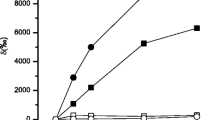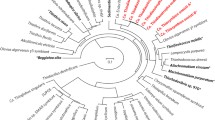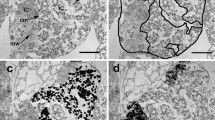Abstract
Solemya reidii (Bernard, 1980) were collected by Van Veen grab near a sewage outfall in California, USA, in spring/early summer of 1984 and 1985. Fixation of carbon dioxide by symbiotic chemoautotrophic bacteria in the gills, followed by translocation of the fixed carbon to symbiontfree tissues of the clam has been demonstrated using NaH14CO3 in two types of experiments. The first approach used the technique of tissue autoradiography to determine the exact sites of fixation of carbon dioxide and subsequent utilization of the fixed carbon compounds. Initial deposition (>95% after 10 min) was in the well defined portion of the gill filaments where the symbiotic bacteria reside. The heaviest redeposition of labeled carbon after a 2 d chase period was in the various glandular tissues of the clams (8 to 38% of the gill level). Levels in two of these glandular tissues decreased after a 5 d chase period, probably due to secretion. Significant labeling of muscle tissue, gonads, and the tips of the gill filaments occurred only after the chase periods. In the second approach, rates of initial carbon fixation by symbiotic bacteria and translocation into clam tissues were determined using pulse-chase experiments followed by dissections and assay of the clam tissues for radioactivity. Freshly caught clams fixed carbon at an average rate of 0.8 μmol CO2 g-1 wet weight h-1. In these fresh clams, 88% of the fixed carbon was found in the gills after 2 min incubation periods, with only 44% remaining in the gills after 1 to 1.7 h incubations. Individuals maintained in the laboratory for 100 d had only 5.8% of the RuBP carboxylase (a diagnostic enzyme for autotrophs) activity in their gills compared to freshly caught clams. After 2 min incubations in NaH14CO3, only 21% of the carbon fixed by the “old” clams was found in their gills, and the rate of incoporation into gill tissue was 5.7% of the rate in fresh individuals. These experiments demonstrate that the symbiotic bacteria fix carbon at a high rate, that a significant portion of the carbon fixed by the symbiotic bacteria (>45%) is translocated to the host, and that the translocated carbon is used by the host.
Similar content being viewed by others
Literature cited
Arp, A. J. and J. J. Childress: Sulfide binding by the blood of the hydrothermal vent tube worm Riftia pachyptila. Science, N.Y. 219, 295–297 (1983)
Beedham, G. E. and G. Owen: The mantle and shell of Solemya parkinsoni (Protobranchia: Bivalvia). Proc. zool. Soc. Lond. 145, 405–430 (1965)
Belkin, S., D. C. Nelson and H. W. Jannasch: Symbiotic assimilation of CO2 in two hydrothermal vent animals, the mussel Bathymodiolus thermophilus and the tube worm Riftia pachyptila. Biol. Bull. mar. biol. Lab., Woods Hole 170, 110–121 (1986)
Bernard, F. R.: A new Solemya s. str. from the Northeastern Pacific (Bivalvia: Cryptodonta). Jap. J. Malac. 39, 17–23 (1980)
Bosch, C. et P.-P. Grassé: Cycle partiel des bactéries chimioautotrophes symbiotiques et leurs rapports avec les bactéries symbiotiques et des bactériocytes. C. r. hebd. Séanc. Acad. Sci., Paris 229, 413–419 (1984)
Cavanaugh, C. M.: Symbiotic chemoautotrophic bacteria in marine invertebrates from sulfide-rich habitats. Nature. Lond. 302, 58–61 (1983)
Cavanaugh, C. M.: Symbioses of chemoautotrophic bacteria and marine invertebrates from hydrothermal vents and reducing sediments. In: The hydrothermal vents of the eastern Pacific: an overview. Bull. biol. Soc. Wash. 1985 (6), 373–388 (1985)
Cavanaugh, C. M., S. L. Gardiner, M. L. Jones, H. W. Jannasch and J. B. Waterbury: Prokaryotic cells in the hydrothermal vent tube worm Riftia pachyptila Jones: possible chemoautotrophic symbionts. Science, N.Y. 213, 340–342 (1981)
Felbeck, H.: Chemoautotrophic potential of the hydrothermal vent tube worm, Riftia pachyptila Jones (Vestimentifera). Science, N.Y. 213, 336–338 (1981)
Felbeck, H.: Sulfide oxidation and carbon fixation by the gutless clam Solemya reidi: an animal-bacterial symbiosis. J. comp. Physiol. 152, 3–11 (1983)
Felbeck, H., J. J. Childress and G. N. Somero: Biochemical interactions between mollusks and their algal and bacterial symbionts. In: The Mollusca, Vol. 2. pp 331–358. Ed. by P. W. Hochachka. New York: Academic Press 1983a
Felbeck, H., G. Liebezeit, R. Dawson and O. Giere: CO2 fixation in tissues of marine oligochaetes (Phallodrilus leukodermatus and P. planus) containing symbiotic, chemoautotrophic bacteria. Mar. Biol. 75, 187–191 (1983b)
Fisher, C. R. and J. J. Childress: Carbon fixation and translocation by symbiotic bacteria in Solemya reidi (Bivalvia: Protobranchia). Am. Zool. 24, p. 57 a (1984)
Fisher, M. R. and S. C. Hand: Chemoautotrophic symbionts in the bivalve Lucina floridana from seagrass beds. Biol. Bull. mar. biol. Lab., Woods Hole 167, 445–459 (1984)
Flitney, E.: Autoradiography. In: Theory and practice of histological techniques, pp 564–583, Ed. by J. P. Bancroft and A. Stevens. Edinburgh: Churchill Livingstone 1982
Giere, O.: The gutless marine oligochaete Phallodrilus leukodermatus. Structural studies on an aberrant tubificid associated with bacteria. Mar. Ecol. Prog. Ser. 5, 353–357 (1981)
Goreau, T. F., N. I. Goreau and C. M. Yonge: On the utilization of photosynthetic products from zooxanthellae and of a dissolved amino acid in Tridacna maxima f. elongata (Mollusca: Bivalvia). J. Zool., Lond. 169, 417–454 (1973)
Gray, P.: Hand book of basic microtechnique, 3rd ed. 302 pp. McGraw-Hill 1964
Grassle, J. F.: Hydrothermal vent animals: distribution and biology. Science, N. Y. 229, 713–717 (1985)
Hammen, C. S.: Carbon dioxide fixation in marine invertebrates-V. Rate and pathway in the oyster. Comp Biochem. Physiol. 17, 289–296 (1966)
Hammen, C. S. and S. C. Lum: Carbon dioxide fixation in marine invertebrates-III. The main pathway in flatworms. J. biol. Chem. 237, 2419–2422 (1962)
Jannasch, H. W.: Microbes in the oceanic environment. In: The microbe 1984: Part II prokaryotes and eukaryotes, pp 97–122. Ed. by D. P. Kelly and N. G. Carr. Cambridge, U.K.: University Press 1984. (Society for General Microbiology)
Jannasch, H. W. and C. O. Wirsen: Chemosynthetic primary production at East Pacific sea floor spreading centers. BioSci. 29, 592–598 (1979)
Karl, D. M., C. O. Wirsen and H. W. Jannasch: Deep-sea primary production at the Galápagos hydrothermal vents. Science, N.Y. 207, 1345–1347 (1980)
Owen, G.: A note on the habits and nutrition of Solemya parkinsoni (Protobranchia: Bivalvia). Q. Jl microsc. Sci. 102, 15–21 (1961)
Powell, M. A. and G. N. Somero: Sulfide oxidation occurs in the animal tissue of the gutless clam, Solemya reidi. Biol. Bull. mar. biol. Lab., Woods Hole 169, 164–181 (1985)
Rau, G. H.: Hydrothermal vent clam and tube worm 13C/12C: further evidence of nonphotosynthetic food sources. Science, N.Y. 213, 338–340 (1981)
Rau, G. H. and J. I. Hedges: Carbon-13 depletion in a hydrothermal vent mussel: suggestion of a chemosynthetic food source. Science, N.Y. 203, 648–649 (1979)
Reid, R. G. B.: Aspects of the biology of a gutless species of Solemya (Bivalvia: Protobranchia). Can. J. Zool. 58, 386–393 (1980)
Reid, R. G. B. and F. R. Bernard: Gutless bivalves. Science, N.Y. 208, 609–610 (1980)
Rogers, A. W.: Techniques of autoradiography, 338 pp. New York: Elsevier (1969)
Schweimanns, M. and M. Felbeck: Significance of the occurrence of chemoautotrophic bacterial endosymbionts in lucinid clams from Bermuda. Mar. Ecol. Prog. Ser. 24, 113–120 (1985)
Southward, A. J., E. C. Southward, P. R. Dando, G. H. Rau, H. Felbeck and H. Flügel: Bacterial symbionts and low 13C/12C ratios in tissues of Pogonophora indicate unusual nutrition and metabolism. Nature, Lond. 293, 616–620 (1981)
Southward, E. C.: Bacterial symbionts in Pogonophora. J. mar. biol. Ass. U.K. 62, 889–906 (1982)
Spiro, B., P. B. Greenwood, A. J. Southward and P. R. Dando: 13C/12C ratios in marine invertebrates from reducing sediments: confirmation of nutritional importance of chemoautotrophic endosymbiotic bacteria. Mar. Ecol. Prog. Ser. 28, 233–240 (1986)
Strickland, J. D. H. and T. R. Parsons: A practical handbook of seawater analysis, 2nd ed. Bull. Fish. Res. Bd Can. 167, 1–310 (1972)
Trench, R. K.: Synthesis of a mucous cuticle by a zoanthid. Nature, Lond. 227, 1155–1156 (1970)
Trench, R. K., R. W. Greene and B. G. Bystrom: Chloroplasts as functional organelles in animal tissues. J. Cell Biol. 42, 404–417 (1969)
Trench, R. K., D. S. Wethey and J. W. Porter: Observations on the symbiosis with zooxanthellae among the Tridacnidae (Mollusca, Bivalvia). Biol. Bull. mar. biol. Lab., Woods Hole 161, 180–198 (1981)
Wishnick, M. and M. D. Lane: Ribulose diphosphate carboxylase from spinach leaves. Meth. Enzym. 23, 570–577 (1971)
Author information
Authors and Affiliations
Additional information
Communicated by R. S. Carney, Moss Landing
Rights and permissions
About this article
Cite this article
Fisher, C.R., Childress, J.J. Translocation of fixed carbon from symbiotic bacteria to host tissues in the gutless bivalve Solemya reidi . Marine Biology 93, 59–68 (1986). https://doi.org/10.1007/BF00428655
Accepted:
Issue Date:
DOI: https://doi.org/10.1007/BF00428655




